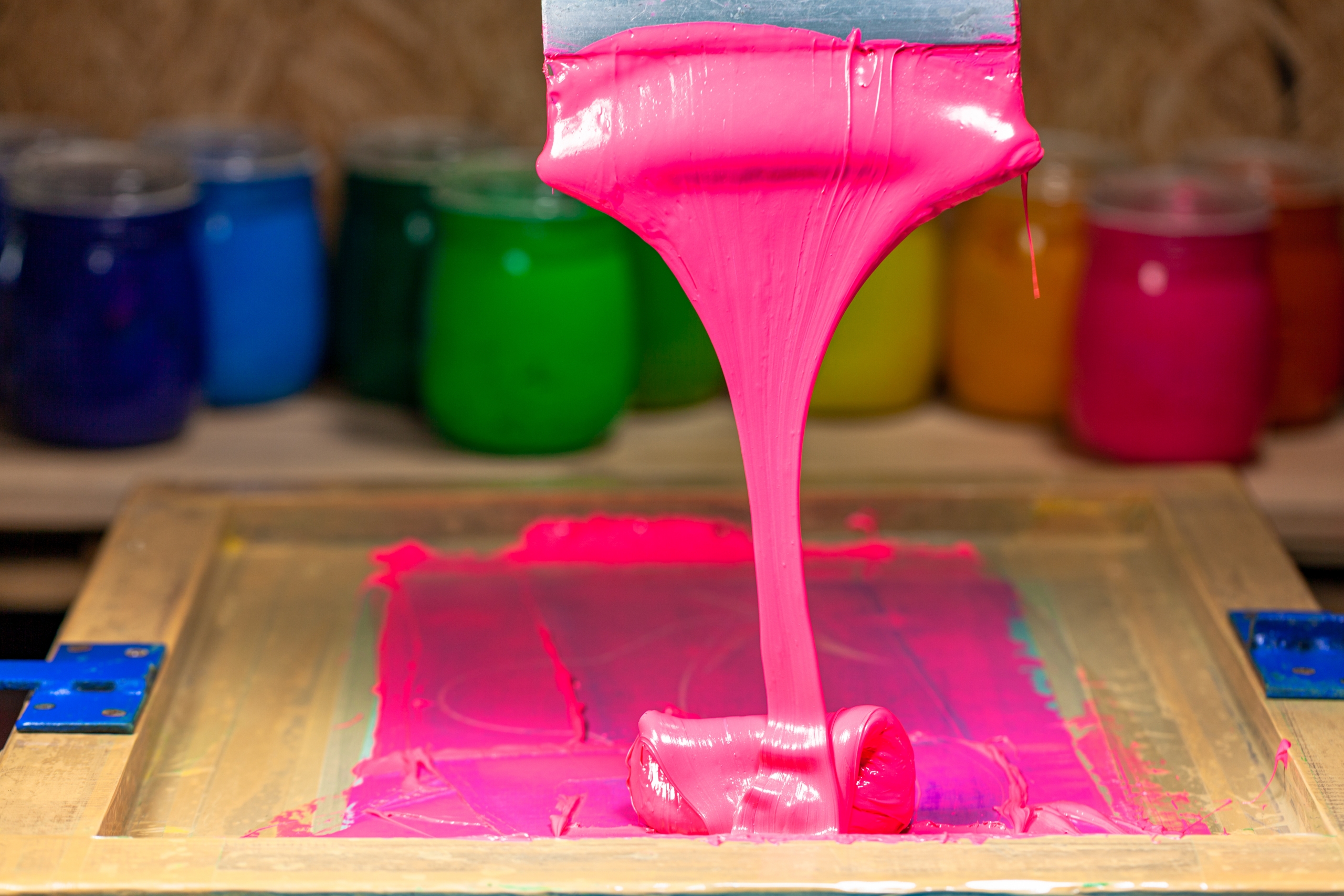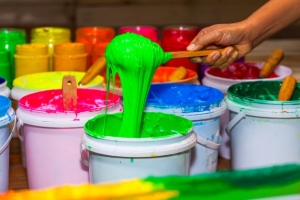Screen Printing Ink
If you’re looking for screen printing services, it might seem like there are too many factors to consider. But once you know what’s essential, choosing the suitable material for your prints becomes much more manageable.
In essence, screen printing uses a stencil to transfer ink or paint to a substrate such as fabric, paper, canvas, wood, etc. The stencil itself is placed over the substrate, and ink or paint is applied to the stencil. A squeegee is then moved across the stencil, forcing the ink or paint through the holes in the stencil and onto the substrate.
Screen printing is one of the most popular methods of apparel decoration today. A lot of people use it because of the variety of colors and designs that are possible. But there are some things to consider when choosing a screen printing ink.
The type of fabric you use affects how well your colors mix. Some fabrics absorb ink better than others, meaning that your colors won’t bleed into each other. Other fabrics don’t hold ink very well, so your colors will wash out quickly. Choose a good-quality fabric if you want your prints to look sharp and vibrant.
Ink types vary widely depending on the application. For example, water-based inks work great for garments because they dry fast and don’t smear easily. Water-based inks are also less likely to cause problems with heat-sensitive materials. On the other hand, solvent-based inks offer a variety of benefits, including the ability to penetrate thick fabrics. You’ll find solvent-based inks for everything from automotive graphics to outdoor signage.
Your ink choice depends on the project you plan to print. If you’re making something small, you probably don’t need a high-resolution image. However, if you’re printing large signs, billboards, or vehicle wraps, you’ll want to make sure you pick a high-resolution ink.
What is in ink?
Fundamentally the main ingredients for ink are pigment to color the ink carrier and binder to glue the ink to the substrate. Inks are generally classified into six categories based on the type of transfer used to carry the pigments. These include water, oil, solvent, wax, emulsion, and UV-curable inks. Water-based inks contain water as the carrier, while oil-based inks use oils such as mineral spirits, vegetable oils, or synthetic hydrocarbon oils as carriers. Solvent-based inks use benzene, xylene, toluene, petroleum ether, ethyl acetate, and methylene chloride to carry the pigments and binders.
Water-Based, Plastisol, and Dischage Inks
Water Based Inks
Water-based inks use dyes or pigmented particles suspended in a water solution and solvents like glycerin. They are usually used for printing on clothing because they tend to hold up better to washing.
Plastisol Inks
These inks contain no pigment or dye and are typically used for screen printing. Discharge inks dry quickly and don’t require heat curing.
Plastisol inks are a form of permanent ink designed to stick to fabrics permanently. These inks are made from polyvinyl chloride (PVC), which makes them very durable and waterproof.
Discharge Printing
Discharge printing is ink to bleach the manufacturer’s dye out of a shirt. The inks are usually water-based and come pre-mixed with different colors. A typical discharge print job includes several steps, including cutting, washing, drying, pressing, and dying.
Water-Based Ink
Water-based ink differs from dye-sublimation, flexographic, gravure, silkscreen, and offset lithography. It’s much like traditional screen printing, except it uses water rather than oil or acrylic paint. This makes it an excellent choice for apparel because it works well on most fabrics without causing shrinkage or fading.
Water-based inks contain water as the primary solvent for carrying colorant. They are made mainly of acrylic resins or hybrids of acrylic resin and polymers. Water-based ink will penetrate fabrics better than plastisol and provide a softer print because much of the ink is made of soft resins and water evaporation during the curing process.
The critical difference between water-based and conventional screen printing is how the ink is applied. Instead of spraying the fabric, water-based ink is deposited directly onto the material’s surface during the printing process. Because of this, there are fewer restrictions on what materials you can use for printing.
In addition to clothing, water-based ink can be used for many other products, including bags, electronics, banners, signage, and even murals.
Water-Based Screen Printing Process
The process of water-based printing is quite simple. First, you must wash the garment thoroughly. Then, you apply the ink onto the garment’s surface using a roller. After that, you roll the garment over a heated plate where the heat melts the binder resin and transfers the ink into the material. This process takes about 10 minutes per side. Once the ink has been applied, the garment is placed in an oven to dry. You can iron the garment to set the ink when the drying process is complete.
For discharged printing, you simply take a piece of plastic film, place the garment inside, close the lid and press down firmly. The ink is transferred onto the garment as soon as the pressure is released. This process usually takes less than one minute.
Plastisol Ink
Plastisol ink has been around since the 1970s and has become one of the most popular print media options for designers and manufacturers. It offers a variety of benefits, including high speed, long-lasting prints, easy cleanup, and excellent color retention. There are three main types of plastisol ink: water-based, solvent-based, and oil-based. Each type works differently depending on the application. Water-based ink is typically recommended for garments, while solvent-based ink is best for sportswear. Oil-based ink is best for heavy-duty applications like industrial workwear or automotive interiors.
Plastisol ink consists of polyvinyl chloride (PVC) resin and plasticizers. These materials can only be mixed if they are completely cured. To cure them, they must be heated above 100 degrees Celsius. When these materials are not fully cured, they cannot adhere to each other. Therefore, the possibility of ink drying on the screen or mesh is very low. However, this process does limit how soft you can make your prints.
Plastisol Screen Printing
Rocky Mountain Apparel offers high-quality, affordable plastisol screen printing services to businesses across Denver, Colorado. We are committed to providing our customers with the highest quality workmanship possible. Whether a one-color print job or a large-scale multi-color job, we’ll give you the best value for money solution.
We offer various sizes of plastic sheets, including polycarbonate, acrylic, and PVC. We can produce a custom size sheet for you, whatever material you choose. Depending on your needs, we can either cut your materials into individual pieces or use pre-cut sheets.
Our experienced team of designers and printers can handle almost anything you throw at us. From logos and graphics to full-scale branding campaigns, we’ve got you covered.
Benefits of Plastisol Ink
Plastisol ink is a plastic resin mixed with pigments and applied to fabric via hand or machine. This method allows for incredibly vibrant prints that won’t fade or bleed. The advantages of its use go way beyond just being able to print vivid images. Its versatility makes it ideal for a wide range of applications. From clothing to home decor, there are endless possibilities of applications.
Eco Friendly
Unlike traditional screen printing methods, plastisol ink does not require toxic chemicals or solvents. You won’t have to worry about potentially harming yourself or the environment. Plus, you’ll save money by doing away with the extra cleaning costs.
Versatile
You can apply it to almost anything. Whether you want to make a statement on canvas or design a t-shirt, plastisol ink is perfect for both. It’s great for creating large designs because it doesn’t dry out like vinyl. And, it’s easy to work with, thanks to the low viscosity.
Discharge Screen Printing
Discharge Ink is a traditional, low-solids, water-based printing ink. It’s different from standard water-based printing inks because no binders are added to ensure the colors don’t bleed together. Instead, the dyes are removed during the printing process. This is why we call it discharged.
The discharge ink doesn’t contain dyes or pigments; instead, it contains a chemical compound called polyvinyl alcohol (PVA). PVA dissolves the dye and pigment in the fabric, allowing the ink to penetrate the fabric’s fibers and take over. Afterward, the ink becomes part of the fabric, and the original colors are gone forever.
In the world of discharge printing, many different types of screens are used to achieve different effects. Some screens are designed to produce an excellent, detailed black image, while others are meant to create a much softer, less defined look. Discharge printing offers a lot of flexibility, and it’s often used to give prints a unique feel. In addition to being able to choose between several different colors, you can even choose to add a special effect like metallic shine or glow.
Darker colored items work better because they absorb the ink better. To get darker colors on darker fabrics, you must use discharge printing. This type of printing works by applying a chemical called an activator to the garment’s surface. When the ink hits the activator, the dye becomes activated and takes on the color of the activator. This allows you to create any color on your clothing without worrying about bleeding.
Need Screen Printing Services?
At Rocky Mountain Apparel, we’ve been perfecting our screen printing processes and taking great pride in our operations’ simplicity, speed, and safety. We strive daily to provide you with the best customer service possible because we know its importance. Our mission is simple: To ensure everyone gets what quality of service they want. Whether it’s a custom logo design, a unique t-shirt, or a one-of-a-kind product, we are committed to providing you with the highest quality products and outstanding customer service.


